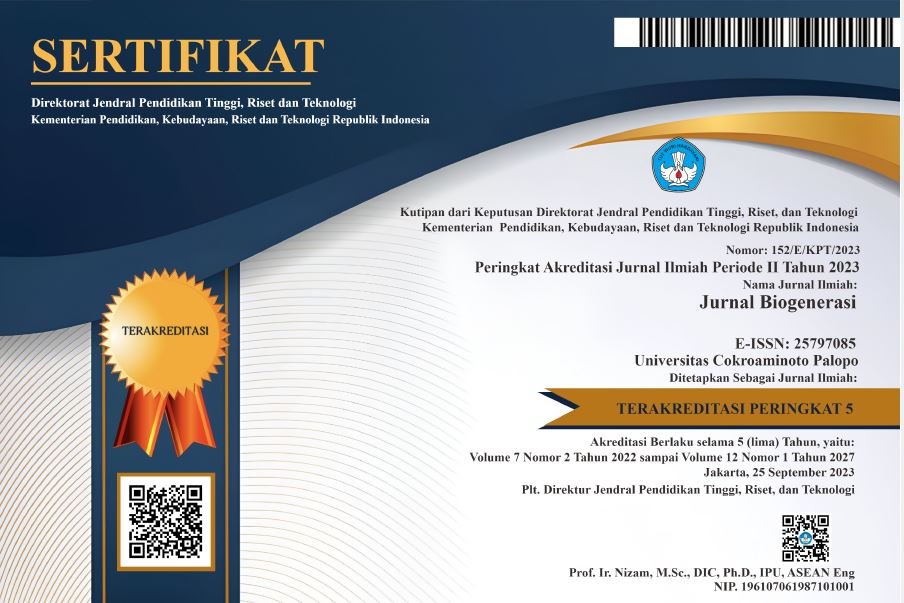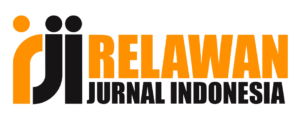Fitoremediasi Limbah Deterjen Menggunakan Tumbuhan Kiambang (Pistia stratiotes) Untuk Mengatasi Pencemaran Lingkungan
DOI:
https://doi.org/10.30605/biogenerasi.v9i2.4759Keywords:
Kiambang (Pistia stratiotes), Environmental pollution, Detergent waste, PhytoremediationAbstract
Water pollution by detergent waste is a serious environmental problem because it contains chemical compounds such as phosphates and surfactants that are difficult to decompose. The Pistia stratiotes (kiambang) plant is a water weed that pools on the surface and is often used as an aquarium filler or as an interior ornament for water ponds. The benefits of aquatic plants such as kiambang can reduce the concentration of pollutants in waste through the phytoremediation process. This research aims to determine the ability of the kiambang plant (Pistia stratiotes) as a phytoremediation agent in reducing the level of water pollution and improving the quality of water exposed to detergent waste. The research method used was experimentation with variations in kiambang mass (50 g, 100 g, 150 g) in detergent wastewater samples. The research results show that the greater the mass of kiambang plants, the more effective it is in reducing water pH and improving water quality. The largest decrease in pH occurred in the treatment with a kiambang mass of 150 g after seven days, reaching an average pH value of 7.78. Phytoremediation with kiambang has been proven to be an environmentally friendly solution for managing detergent waste and helping restore aquatic ecosystems.
Downloads
References
Anonimus. (2004). Pencemaran Air. Diakses dari http:/ www. terranet. or. id/tulisan detil. php? Id =1566 pada tanggal 18 November 2004.
Audiyanti. S, Hasan. Z, Hamdani. H, Herawati. H. (2019). Efektivitas Eceng Gondok (Eichhornia Crassipes) Dan Kayu Apu (Pistia Stratiotes) Sebagai Agen Fitoremediasi Limbah Sungai Citarum. Jurnal Perikanan Dan Kelautan. 10(1) : 111-116
Apriyani, N. (2017). Penurunan Kadar Surfaktan dan Sulfat dalam Limbah Laundry. Jurnal Media Ilmiah Teknik Lingkungan.2(1): 37–44.
Fajarianingtyas, D. A., Retnaningdyah, C., & Arisoesilaningsih, E. (2012). Peningkatan Kualitas Limbah Deterjen Dengan Fitoremediasi Menggunakan Diversitas Hidromakrofita Indonesia. LENSA (Lentera Sains): Jurnal Pendidikan IPA, 2(2), 19-27.
Hermawati, E.Dkk. (2005).Fitoremediasi Limbah Detergent Menggunakan Kayu Apu ( Pistia Stratiotes L.) Dan Genjer (Limnocharis Flava L.).Biosmart.7(2):117. Http://Biosmart.Mipa.Uns.Ac.Id/Index.Php/Biosmart/Artic
Nurfadillah,A Awaliyan,N ,A, Nurinsa. (2016). Fitoremediasi Limbah Domestik (Detergent) Menggunakan Eceng Gondok (Eichorniacrassipes) Untukmengatasi Pencemaran Lingkungan. Jurnal PENA .3 .(2) .2355-3766.
Muhsinin, N. (2019). Pengolahan Air Limbah Domestik Secara Fitoremediasi Sistem Constructed Wetland Dengan Tanaman Pandanus Amaryllifolius Dan Azolla Microphilla. Journal Of Chemical Information And Modeling. 53(9), 1689–1699.
Suraya, U. 2019. Inventarisasi Dan Identifikasi Tumbuhan Air Di Danau Hanjalutung Kota Palangka Raya. Jurnal Daun. 6(2), 149-159.
Yustika,V.,Kasim,N,M.,Andimala,F.Amboy,M.,Daaliwa,S,M.,Nurlisa,W,O., Kunusa,K,R.(2022). Jurnal Inovasi Teknik Kimia.7(2):14-22.
Wandhana. (2013). Pengolahan Air Limbah Laundry Secara Alami (Fitoremediasi) Dengan Tanaman Kayu Apu (Pistia Stratiotes). Universitas Pembangunan Nasional Veteran Jawa Timur.
Downloads
Published
How to Cite
Issue
Section
License
In submitting the manuscript to the journal, the authors certify that:
- They are authorized by their co-authors to enter into these arrangements.
- The work described has not been formally published before, except in the form of an abstract or as part of a published lecture, review, thesis, or overlay journal.
- That it is not under consideration for publication elsewhere,
- That its publication has been approved by all the author(s) and by the responsible authorities – tacitly or explicitly – of the institutes where the work has been carried out.
- They secure the right to reproduce any material that has already been published or copyrighted elsewhere.
- They agree to the following license and copyright agreement.
License and Copyright Agreement
Authors who publish with this journal agree to the following terms:
- Authors retain copyright and grant the journal right of first publication with the work simultaneously licensed under Creative Commons Attribution License (CC BY 4.0) that allows others to share the work with an acknowledgment of the work's authorship and initial publication in this journal.
- Authors are able to enter into separate, additional contractual arrangements for the non-exclusive distribution of the journal's published version of the work (e.g., post it to an institutional repository or publish it in a book), with an acknowledgment of its initial publication in this journal.
- Authors are permitted and encouraged to post their work online (e.g., in institutional repositories or on their website) prior to and during the submission process, as it can lead to productive exchanges, as well as earlier and greater citation of published work.


.png)

